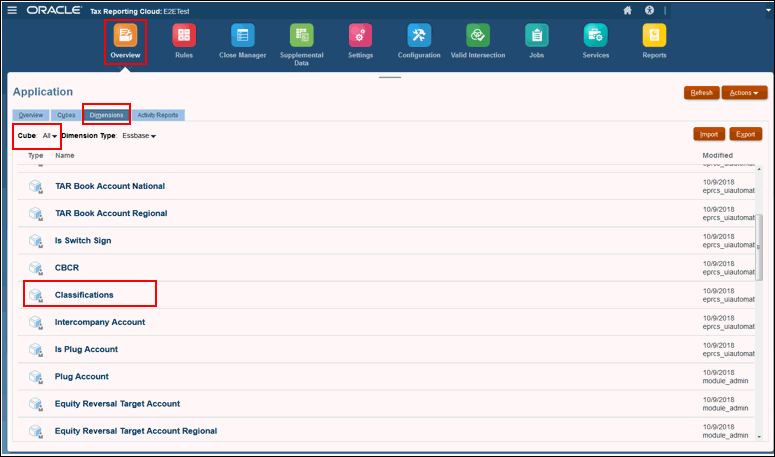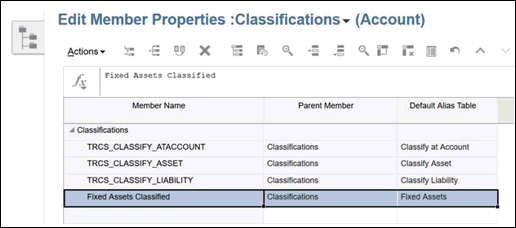Classifying Deferred Tax Assets and Liabilities
By default, deferred tax classifies each temporary difference account, based on Total Deferred Tax amount (TRCS_NDefTaxNetVA).
- If the Total Deferred Tax is positive (greater than or equal to zero), then all temporary difference accounts are classified as Noncurrent Assets.
- If the Total Deferred Tax amount is negative (less than zero), each temporary difference account is classified as a Noncurrent Liability.
If you require additional flexibility, you can use the Classifications attribute to define how both National and Regional accounts can be classified.
The following out-of-the-box system members exist:
•TRCS_Classify_ATACCOUNT: When assigned to a level 0 temporary difference account, it is classified based on its closing balance value.
•TRCS_Classify_ASSET: When assigned to a level 0 temporary difference account, it is always classified as a Noncurrent Asset ignoring its closing balance.
•TRCS_Classify_LIABILITY: When assigned to a level 0 temporary difference account, it is always classified as a Noncurrent Liability ignoring its closing balance.
In addition to the out-of-the-box Classification attribute members above (for example, Total Fixed Assets), you can create additional custom attribute members. When a custom attribute is assigned to multiple level 0 temporary difference accounts, the total Closing Balance of those accounts determines the classification for all the accounts assigned the custom attribute.
To classify deferred tax assets and liabilities:
- From the Home page, click Applications, then Overview, and then Dimensions.
- Under Cubes, select All. This ensures that Classifications is displayed on the Dimensions tab.
- Under Name, select Classifications.

- On Edit Member Properties: Classifications (Account), view the out-of-the-box Classification attribute members:
•TRCS_Classify_ATACCOUNT: When assigned to a level 0 temporary difference account, it is classified based on its closing balance value.
•TRCS_Classify_ASSET: When assigned to a level 0 temporary difference account, it is always classified as a Noncurrent Asset ignoring its closing balance.
•TRCS_Classify_LIABILITY: When assigned to a level 0 temporary difference account, it is always classified as a Noncurrent Liability ignoring its closing balance.

- To create a custom classification group name, perform the following steps:
- On Edit Member Properties: Classifications (Account), click the Add Child icon
 .
.
- On the Add Child dialog box, enter the number of members you want to add, and then click Apply. The Parent Member is displayed as Classifications.
- Enter the Member Name of the custom classification group, and then click Save.
- Optional: Enter the name of the Alias Table.
- On Edit Member Properties: Classifications (Account), click the Add Child icon
- On the Applications page, click Dimensions, and then click Account.
- On the Edit Member Properties: Account screen, navigate to the Member Name, and configure the classification group as required by selecting options from each column.

- Scroll to the Classifications column, then select the level 0 temporary differences account (default or custom) with which the member is to be associated.
- Under the Classifications column, select the appropriate classification group name and assign it to the Account.
- Click Save.
- After the classification groups have been assigned, under Actions, select Refresh Database.
- From the Home page, select Tax Provision National or Tax Provision Regional, as required.
- Under Actions, select Consolidate.
- From the Home page, select Tax Provision National or Tax Provision Regional, as required, then select Package, and then the Temporary Differences report.
- Highlight the Total Temporary Differences account, and then scroll to the Temporary Differences Closing Balance column on the far right of the report to verify the closing balance.
- On the Package tab, select the Deferred Tax report, and verify that the Deferred Tax Asset and Deferred Tax Liability classifications based on your configuration are correct.
- From the Home page, click TAR (Tax Account Rollforward Report), and under Total Deferred Tax , verify that the Deferred Tax Asset and Deferred Tax Liability classifications based on your configuration are correct.